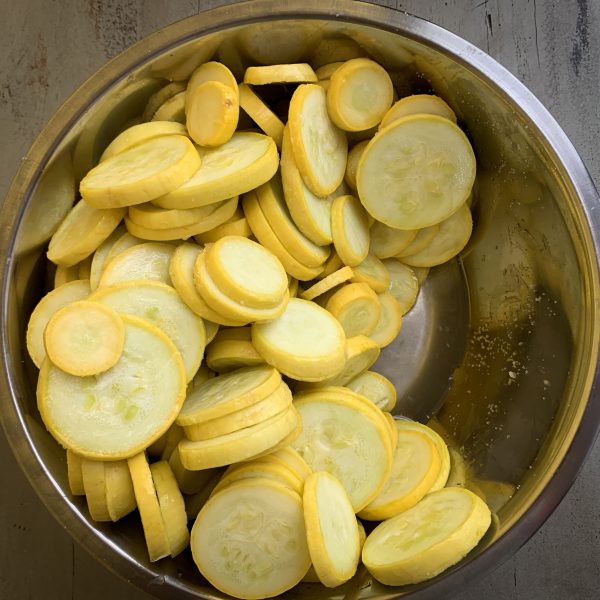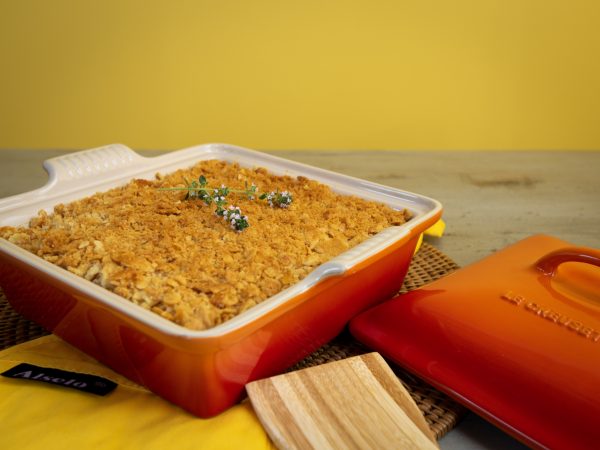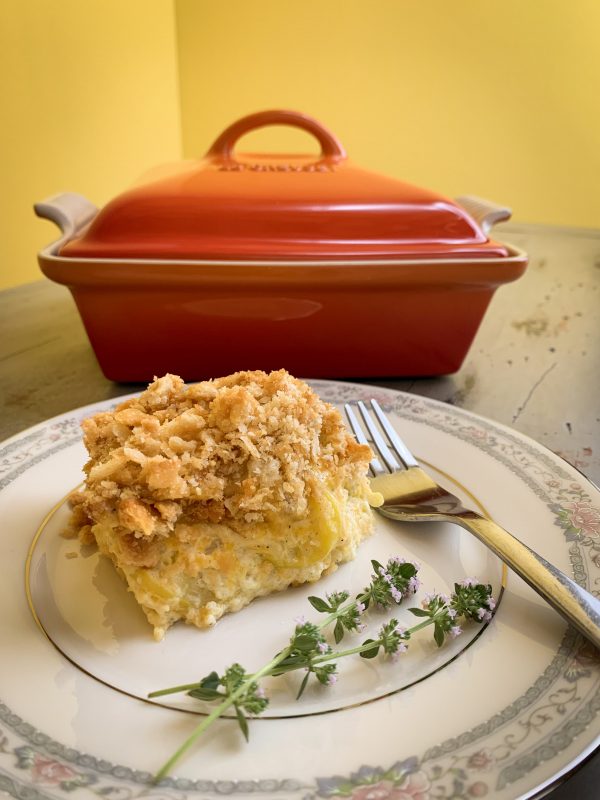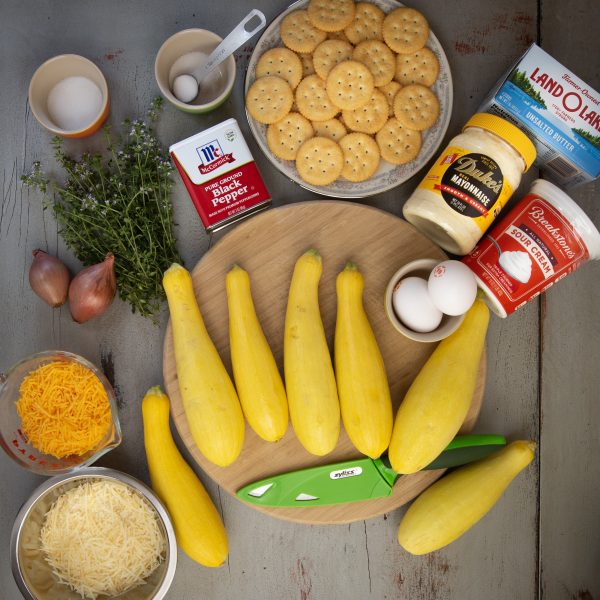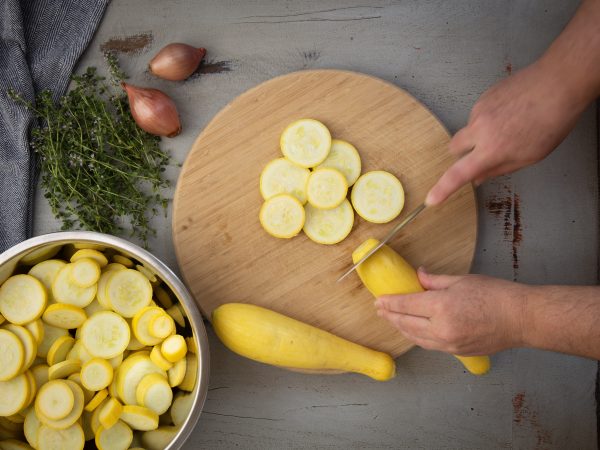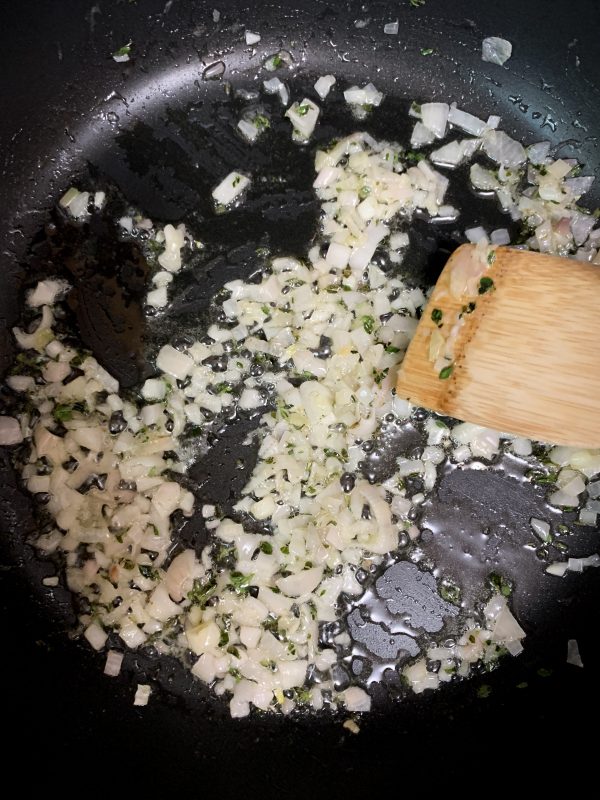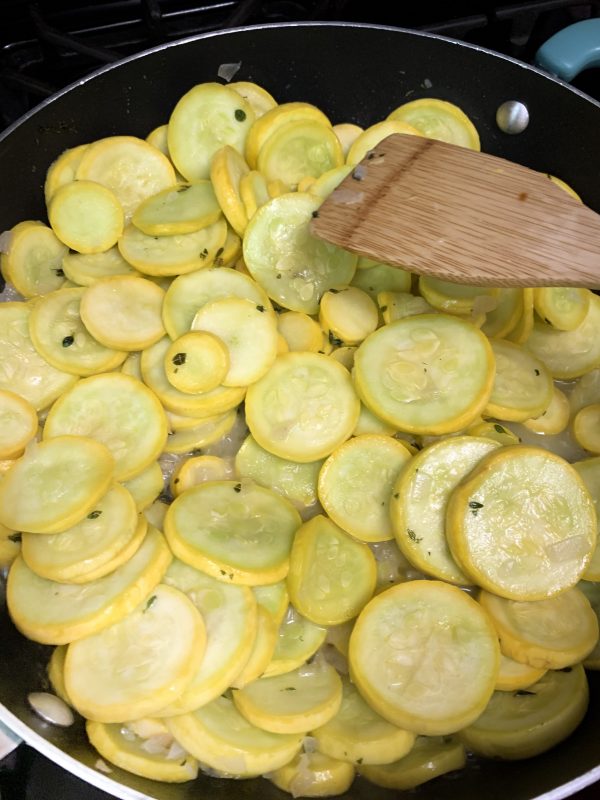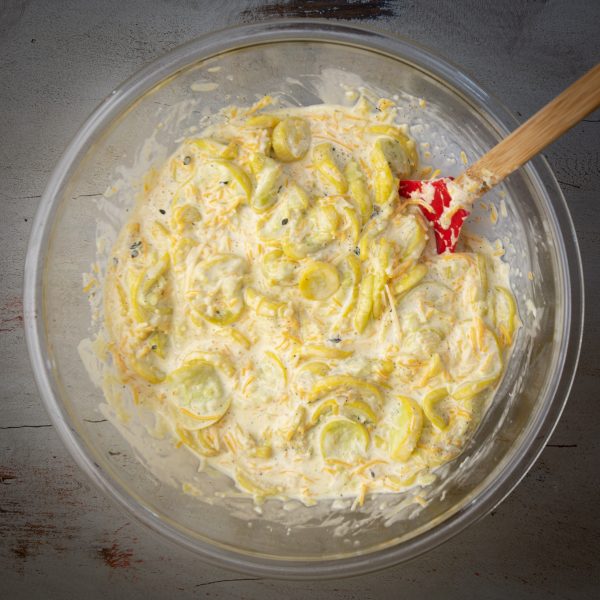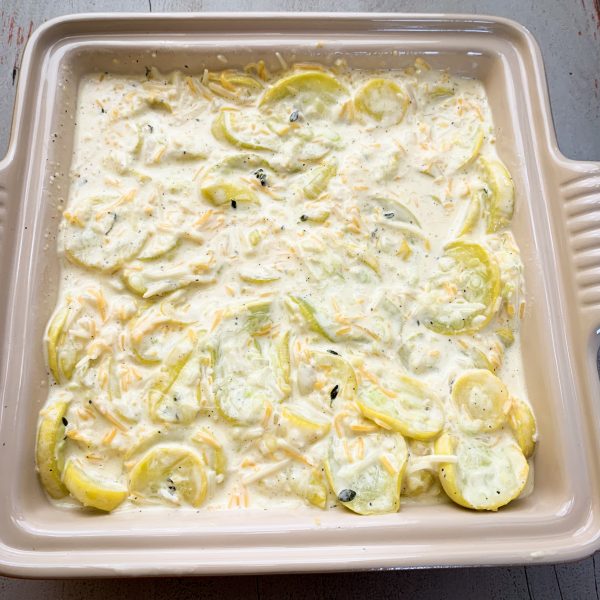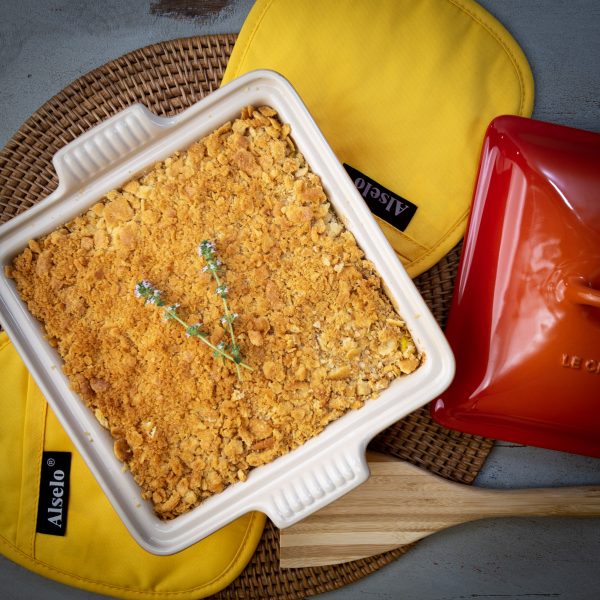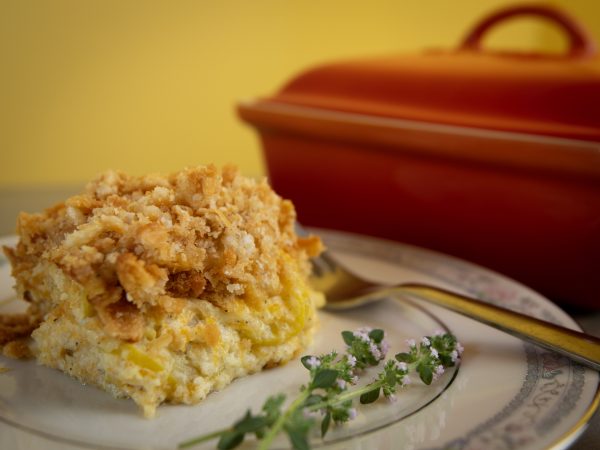The Perfect Squash Casserole Recipe
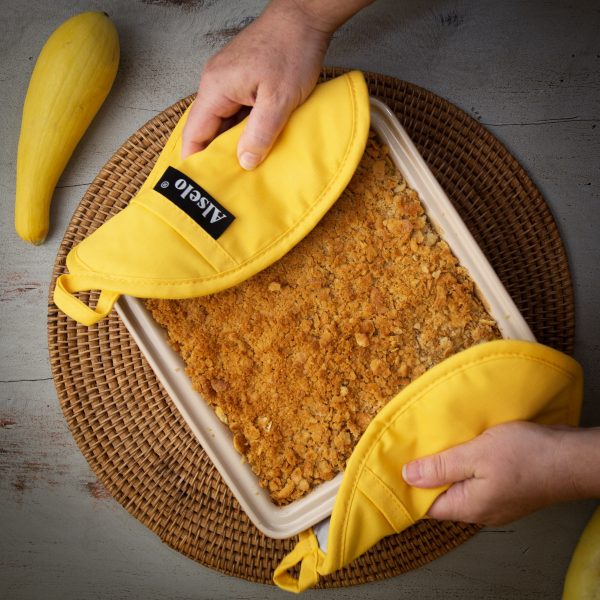
If you grew up in the South like I did, then you likely have a list of Southern comfort foods – a.k.a. squash casserole – that help you feel close to home. There’s nothing like good ole country home cooking to remind you of who you are and the way the world should be.
Squash casserole always brings back fun memories of family reunions and potluck dinners. I don’t know about you, but I always survey the spread and prioritize what I’m going to fill my plate with first. In my family, the squash casserole and my aunt’s sweet potato casserole with pecan streusel always disappeared quickly. So, if I was going to get any, I had to move with haste.
Why This Squash Casserole Recipe Works
Squash casserole is a cornerstone of Southern cooking, a cherished recipe passed down through generations. It’s the perfect way to celebrate the bounty of summer gardens, turning humble yellow squash into a rich, creamy, and utterly comforting side dish. Its popularity stems from its simplicity and its ability to pair beautifully with almost any main course, from holiday hams to weeknight fried chicken. It’s a familiar taste of home for so many of us.
But even classics can be polished to a brighter shine. The biggest challenge with any squash casserole is managing the moisture. Yellow squash is packed with water, which can lead to a soupy, disappointing result if you’re not careful. This recipe tackles that problem head-on with a crucial first step: salting and draining the squash. This simple technique draws out a surprising amount of liquid, concentrating the squash’s flavor and ensuring a perfectly creamy, never watery, texture in the final dish.
What truly sets this recipe apart, however, is the flavor profile. Instead of the sometimes overpowering bite of a yellow onion, we use a finely chopped shallot. Shallots offer a milder, slightly sweeter flavor that complements the squash without dominating it. The real secret weapon is the lemon thyme. This isn’t just regular thyme; its distinct citrusy aroma adds a layer of brightness and sophistication that elevates the entire casserole. It cuts through the richness of the cheese, sour cream, and buttery crackers, making each bite feel vibrant and new. This thoughtful combination of technique and ingredients is why this squash casserole recipe is a guaranteed showstopper.
MANAGING THE WATER
What I never knew as a kid was that squash casserole is incredibly easy to make!
The ingredients for squash casserole are fairly simple. You probably have most of them in your pantry already. The trick is managing the water, which I’ve noticed a lot of recipes don’t tell you about.
Most squash casserole recipes call for a yellow onion, which is full of water. I like to use a purple shallot instead. They may be small in comparison but are quite pungent. So, you get the onion flavor you need without turning your casserole into soup.
Squash itself also has a high water content. So, after slicing the squash, I cover it in salt and let it sit for a good 30 minutes. I’m always amazed at how much water is sitting in the bottom of the bowl when I go to drain it.
I bet I poured off a good two cups of water when I made this recipe today.
MAKE IT SOUTHERN!
I always laugh when people claim Southern cooking tastes “just as good” with low-fat ingredients. The whole concept behind Southern cooking is using what’s available on a farm.
That’s why the best squash casserole recipes call for butter, full-fat cheeses, and whole sour cream. These ingredients add a rich flavor that can’t be matched by low-fat alternatives. Sure, you can still make a decent casserole with lower fat ingredients, but I personally prefer to simply enjoy the full-flavored version in moderation.
I also like to add fresh lemon thyme from my garden. Its fragrant aroma fills the whole house. You can substitute regular thyme as well.
GET A CASSEROLE DISH WITH A LID
I love to cook. So, it probably won’t surprise you that I enjoy shopping for tools that make cooking more enjoyable. However, I’m also a busy mom of two active boys. That means I have to be careful to purchase stuff that will make my life easier.
Having one or two reliable casserole dishes is essential for me. Ones with lids hold the heat in, which reduces cooking time.
Colors always brighten my day, so I’m always drawn to the beauty of Le Creuset. You’ll notice from the photos that I used the 2.5 quart Le Creuset Heritage Covered Square Casserole dish for my squash casserole.
That said, there are lots of great casserole dishes out there to choose from. Just make sure you get ones that have lids and that distribute heat evenly.
Most recipes call for a 2.5-3 quart or 3.5-4 quart casserole dish. Both 9×9 inches and 9×13 inches are popular sizes.
Enough about shopping though. Let’s talk about the squash casserole you’re gonna make. This will become your go-to side dish for sure.
SQUASH CASSEROLE INGREDIENTS
Filling Ingredients
- 3 tablespoons of unsalted butter
- 1 shallot – avoids water of onion
- 2 teaspoons of freshly chopped thyme or lemon thyme
- 3 pounds crookneck yellow squash (7-8 medium yellow squash)
- 2 tablespoons of salt for removing excess water from squash (Don’t worry, you’ll be rinsing most of it off.)
- 2 teaspoons of sugar
- ½ teaspoon of black pepper
- 2 large eggs
- 4 ounces of mayonnaise
- 4 ounces of sour cream
- 4 ounces of shredded cheddar cheese
- 4 ounces of shredded parmesan cheese
Topping Ingredients
- 2 sleeves of Ritz crackers
- 2 tablespoons of melted butter
Notes
In a pinch, corn flakes, panko bread crumbs, or crumbled croutons can be used as a substitute for Ritz crackers.
STEP 1: PREPARE THE SQUASH
Slice the squash and put it in a large bowl. Then, sprinkle the squash with plenty of salt. You’ll want to stir it up to make sure the salt coats all of the squash.
After 30 minutes, rinse the squash with cold water and pat dry. This step will remove a considerable amount of moisture and prevent a soggy casserole.
If you never seem to have a sharp knife when you need one, check out Zyliss knives. Ever since I got these affordable knives a few years ago, the expensive knives I received as a wedding gift have mostly gone unused.
STEP 2: SAUTÉ THE SHALLOTS & LEMON THYME
Preheat the oven to 350 ºF. While it’s preheating, melt butter in a large skillet over medium-high heat on your stovetop. Add in your shallots and lemon thyme. Sauté for 1-3 minutes or until the onions are translucent.
STEP 3: SAUTÉ THE SQUASH
Add in the squash and black pepper. Cook for 8-10 minutes until the liquid is released. Remove from heat and drain off any excess liquid.
STEP 4: PREPARE THE FILLING
In a medium-sized mixing bowl, mix together the eggs, sugar, sour cream, and mayonnaise.
Combine the cooked squash and shallot mixture with the eggs, sugar, sour cream, and mayonnaise mixture.
Add in the cheddar and parmesan cheeses. Then stir the mixture well.
STEP 5: FILL THE CASSEROLE DISH
Transfer the filling into the casserole dish. It should be no more than 80% full. If you have more filling than that, set it aside. Having a little extra is always better than cleaning your oven because a casserole overflowed. Believe me… I know!
STEP 6: BAKE THE SQUASH CASSEROLE
Bake covered for 15 minutes. While the casserole is baking, crush two sleeves of Ritz crackers and pour into a medium-sized mixing bowl. If you don’t know what to reach for, a rolling pin makes a great club for crushing!
Melt the butter for the topping and then combine it with the cracker crumbs. When your timer goes off, remove the casserole from the oven and cover it with the cracker crumb mixture. You’ll need potholders for each side since it’s a bit heavy.
Bake uncovered for an additional 15 minutes or until the casserole is golden brown on top. Don’t overcook the casserole, else you’ll end up with mush. Fork an edge to confirm that squash is tender.
STEP 7: LET THE SQUASH CASSEROLE FINISH SETTING
When you pull your squash casserole out of the oven it will continue cooking for a few minutes. You’re best to wait at least 15 minutes before serving. That will allow enough time for the casserole to finish setting. You’ll end up with nice-looking wedges that don’t spill over into other side dishes.
Bon appétit!
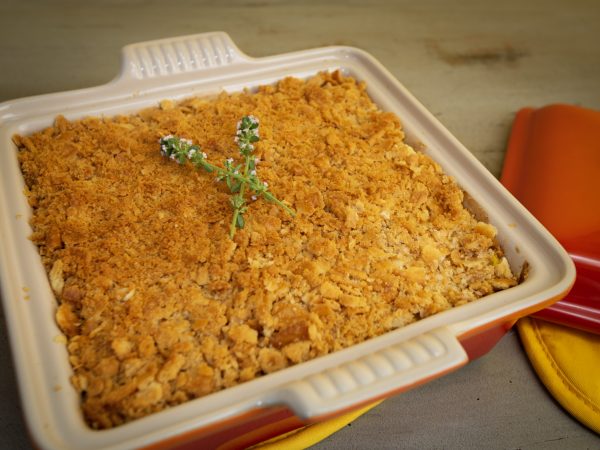
How To Serve Squash Casserole
This squash casserole is so versatile, it feels right at home on almost any table. It’s a classic side dish for a reason, shining brightest next to classic Southern and American main courses. The creamy, cheesy texture and buttery cracker topping make it a perfect companion for everything from a holiday dinner to a simple weeknight meal. It brings a touch of comfort and indulgence that makes any meal feel a little more special.
Think of it as the ultimate team player on your dinner plate. It complements savory, roasted meats wonderfully. For a truly classic Southern feast, you can’t go wrong serving it alongside:
- Fried Chicken: The crispy, salty chicken is a perfect contrast to the soft, creamy casserole.
- Roasted Pork Loin or Tenderloin: The savory herbs of a good pork roast are beautifully echoed by the lemon thyme in the squash.
- Holiday Ham or Turkey: This is a must-have on my Thanksgiving and Easter table. It’s a welcome, cheesy addition to the traditional spread.
- Grilled Steak or Barbecue Ribs: During the summer, this casserole is a fantastic side for a cookout, offering a creamy counterpoint to smoky, grilled flavors.
But don’t feel limited to serving it only as a side dish. For a lighter meal, this squash casserole can easily be the star of the show. I love serving a generous portion with a simple green salad tossed in a bright vinaigrette for a satisfying vegetarian lunch or dinner. You can also scoop it into individual ramekins before baking for elegant, single-serving portions that are perfect for a dinner party or brunch.
How To Store & Reuse Squash Casserole Leftovers
One of the best things about a good casserole is that the leftovers are often just as delicious, if not more so, as the flavors have had more time to meld together. Storing this squash casserole properly is easy and ensures you can enjoy it for a few more days. It’s a wonderful dish to have on hand for quick lunches or to repurpose into something new.
Once the casserole has cooled completely to room temperature, you can store it right in its baking dish. Just cover it tightly with plastic wrap or aluminum foil, or transfer it to an airtight container. Properly stored, it will keep well in the refrigerator for up to 4 days. When you’re ready to reheat, you can do so in the oven or the microwave. For the best results and to re-crisp the topping, I recommend the oven. Simply place the casserole in a 350°F oven for about 15 to 20 minutes, or until it’s heated through. If you’re in a hurry, a minute or two in the microwave works just fine for single servings.
Beyond simply reheating, here are a few of my favorite ways to give the leftovers a second life:
- Savory Breakfast Boost: Stir a scoop of leftover casserole into your scrambled eggs or an omelet for an instant cheesy, vegetable-packed breakfast.
- Quick Pasta Sauce: Thin out a portion of the casserole with a splash of milk or cream, heat it in a small saucepan, and toss it with your favorite pasta for a super-fast and creamy meal.
- Stuffed Chicken Breast: Use the cold casserole as a filling for chicken breasts. Just slice a pocket into the chicken, stuff it, and bake until the chicken is cooked through.
You can also freeze the squash casserole for longer storage. It freezes best before the final bake. Assemble the casserole completely but leave off the cracker topping. Wrap it tightly in a layer of plastic wrap followed by a layer of foil and freeze for up to 3 months. When ready to eat, let it thaw in the refrigerator overnight, then add the fresh cracker topping and bake as directed, adding 10-15 extra minutes to the initial covered baking time.
Substitutions & Variations For Squash Casserole
While I believe this recipe is perfect as is, cooking is all about making a dish your own! There are plenty of ways to adapt this squash casserole to suit your taste, use what you have on hand, or accommodate dietary needs. The base is very forgiving, so feel free to experiment with different flavors and textures.
The most important part of this recipe is managing the squash’s moisture, so as long as you stick to the salting and draining step, your casserole will have a great foundation. From there, you can get creative. If you don’t have shallots, a sweet yellow onion will work, just be sure to cook it down well. No lemon thyme? Regular fresh thyme or even a bit of dried Italian seasoning can be used in its place. These small changes can create a whole new experience.
Here are a few variations you might enjoy trying:
- Cheese Swaps: The cheddar and parmesan combination is classic, but you can create a different flavor profile with other cheeses. Try using Gruyère for a nutty flavor, Monterey Jack for a milder melt, or adding a bit of smoked Gouda for a smoky kick.
- Add More Veggies: Feel free to bulk up the casserole with other vegetables. Sliced mushrooms, diced bell peppers, or even some corn would be delicious additions. Just be sure to sauté them along with the squash to cook off their excess moisture.
- Dietary Adjustments: To make this gluten-free, simply swap the Ritz crackers for your favorite crushed gluten-free crackers or breadcrumbs. For a lower-carb version, you can replace the cracker topping with crushed pork rinds mixed with melted butter and a little parmesan cheese.
- A Touch of Spice: If you like a little heat, add a pinch of red pepper flakes or a dash of your favorite hot sauce to the creamy filling. A finely diced jalapeño, sautéed with the shallot, would also be a fantastic addition.
Think of this recipe as a template. Whether you’re adding bacon for a savory, meaty flavor or topping it with different herbs, the possibilities are endless for this classic squash casserole.
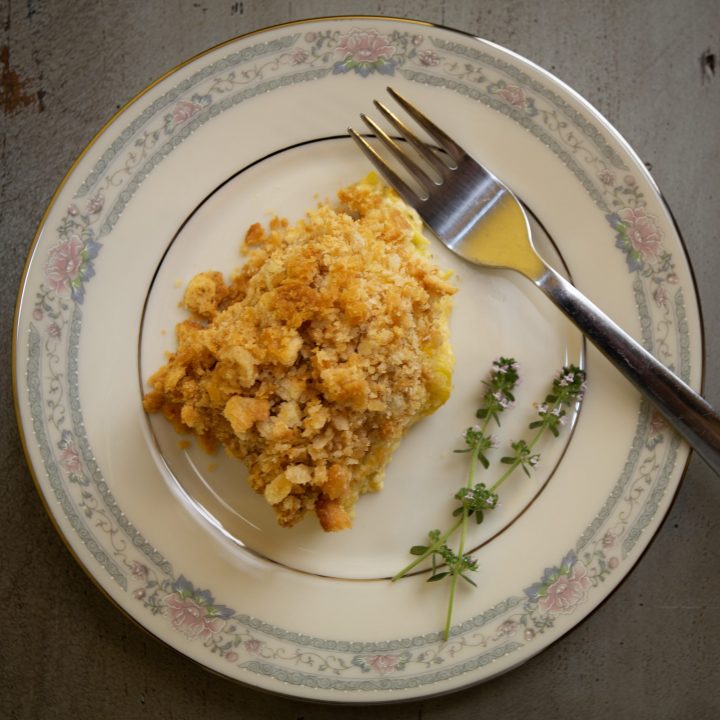
The Perfect Squash Casserole Recipe
Squash casserole always brings back fun memories of family reunions and potluck dinners. In my family, the squash casserole always disappeared quickly, so if I was going to get any, I had to move with haste!
Ingredients
- 3 tablespoons of unsalted butter
- 1 shallot – avoids water of onion
- 2 teaspoons of freshly chopped thyme or lemon thyme
- 3 pounds crookneck yellow squash (7-8 medium yellow squash)
- 2 tablespoons of salt for removing excess water from squash
- 2 teaspoons of sugar
- ½ teaspoon of black pepper
- 2 large eggs
- 4 ounces of mayonnaise
- 4 ounces of sour cream
- 4 ounces of shredded cheddar cheese
- 4 ounces of shredded parmesan cheese
- 2 sleeves of Ritz crackers
- 2 tablespoons of melted butter
Instructions
- Slice the squash and put it in a large bowl. Then, sprinkle the squash with plenty of salt. You’ll want to stir it up to make sure the salt coats all of the squash. After 30 minutes, rinse the squash with cold water and pat dry. This step will remove a considerable amount of moisture and prevent a soggy casserole.
- Preheat the oven to 350 ºF. While it’s preheating, melt butter in a large skillet over medium-high heat on your stovetop. Add in your shallots and lemon thyme. Sauté for 1-3 minutes or until the onions are translucent.
- Add in the squash and black pepper. Cook for 8-10 minutes until the liquid is released. Remove from heat and drain off any excess liquid.
- In a medium-sized mixing bowl, mix together the eggs, sugar, sour cream, and mayonnaise. Combine the cooked squash and shallot mixture with the eggs, sugar, sour cream, and mayonnaise mixture. Add in the cheddar and parmesan cheeses. Then stir the mixture well.
- Transfer the filling into the casserole dish. It should be no more than 80% full. If you have more filling than that, set it aside. Having a little extra is always better than cleaning your oven because a casserole overflowed. Believe me… I know!
- Bake covered for 15 minutes. While the casserole is baking, crush two sleeves of Ritz crackers and pour into a medium-sized mixing bowl. Melt the butter for the topping and then combine it with the cracker crumbs. When your timer goes off, remove the casserole from the oven and cover it with the cracker crumb mixture. You'll need potholders for each side since it's a bit heavy. Bake uncovered for an additional 15 minutes or until the casserole is golden brown on top. Fork an edge to confirm that squash is tender.
- When you pull your squash casserole out of the oven it will continue cooking for a few minutes. You’re best to wait at least 15 minutes before serving. That will allow enough time for the casserole to finish setting. You’ll end up with nice-looking wedges that don’t spill over into other side dishes.
5 FAQs About Squash Casserole
Here are some straightforward answers to the most common questions I receive about this squash casserole recipe.
Why is my squash casserole watery?
This is by far the most common issue people face when making squash casserole, and the answer almost always comes down to one thing: moisture. Yellow squash has an incredibly high water content, and if you don’t take steps to remove it before baking, that water will seep out and create a soupy mess in your casserole dish. The most critical step in this recipe is salting the sliced squash and letting it sit for 30 minutes. The salt works through osmosis to draw a significant amount of water out of the vegetable’s cells. Rinsing and thoroughly patting it dry afterward is equally important.
The second line of defense against a watery casserole is sautéing the squash after it has been salted and dried. This cooking process helps evaporate even more of the remaining moisture. When you’re cooking it in the skillet with the shallots, you should see the liquid release and then cook off. If there’s any liquid left in the pan when you’re done, be sure to drain it off completely before mixing it into the creamy filling. Following these two steps diligently will guarantee a thick, creamy, and perfectly set squash casserole every time.
Can I make this squash casserole ahead of time?
Absolutely! This squash casserole is a great candidate for making ahead, which is one of the reasons it’s so popular for holidays and dinner parties. You have a couple of options depending on how much you want to do in advance. The best method is to prepare the entire casserole right up to the point of baking. Follow all the steps to make the filling and transfer it to your casserole dish. At this stage, cover the dish tightly with plastic wrap or foil and refrigerate it for up to 24 hours.
When you’re ready to bake, I recommend letting the dish sit on the counter for about 30 minutes to take the chill off. While it rests, you can mix up the fresh Ritz cracker topping. Uncover the casserole, sprinkle the topping over it, and bake as directed. You may need to add about 10-15 minutes to the total baking time since you’re starting with a cold filling. This method ensures the topping stays perfectly crispy and the casserole bakes evenly.
Can I freeze squash casserole?
Yes, you can freeze squash casserole, which is perfect for getting a head start on holiday meal prep or for saving leftovers. For the best results, I suggest freezing the casserole unbaked and without the cracker topping. The topping just doesn’t hold up well in the freezer and is much better when made fresh. Assemble the casserole filling as directed, place it in a freezer-safe baking dish, and allow it to cool completely.
Once cool, wrap the dish tightly with a layer of plastic wrap, then a layer of heavy-duty aluminum foil. This double layer helps prevent freezer burn. It can be frozen for up to 3 months. To bake, thaw the casserole overnight in the refrigerator. Let it sit at room temperature for about 30 minutes before baking, then prepare and add the fresh cracker topping. You’ll likely need to add 15-20 minutes to the baking time to ensure it’s heated all the way through. While you can freeze a fully baked casserole, be aware that the texture of the squash might become slightly softer upon reheating.
What kind of squash is best for this squash casserole recipe?
For a classic Southern squash casserole, yellow crookneck squash is the traditional and preferred choice. It has a mild, slightly sweet flavor and a tender texture that is just perfect for this dish. Its distinctive curved neck and bumpy skin are what most people picture when they think of yellow summer squash. When you’re shopping for it, look for smaller to medium-sized squash, as they tend to have fewer seeds and a more delicate flavor than the very large ones.
That being said, if you can’t find crookneck squash, you can absolutely use yellow straightneck squash, which is very similar in taste and texture. You could even make this recipe with zucchini. If using zucchini, the salting step is even more crucial as it also holds a lot of water. The flavor will be slightly different, a bit more earthy, but still delicious. The key is to use a summer squash variety that is fresh and firm.
How do I make a gluten-free squash casserole?
Making a gluten-free version of this squash casserole is very simple because the filling itself is naturally gluten-free. The only ingredient you need to worry about is the Ritz cracker topping. Luckily, there are many excellent substitutes available that will give you that same satisfyingly crunchy and buttery crust on top of your creamy casserole.
Your easiest option is to use your favorite brand of gluten-free crackers. Brands like Schär or Lance make buttery, round crackers that are a great stand-in for Ritz. Simply crush them and mix them with the melted butter as directed. Another fantastic option is to use gluten-free breadcrumbs, either store-bought or homemade from gluten-free bread. For an even more flavorful and low-carb option, you could use crushed pork rinds or a mixture of almond flour, parmesan cheese, and melted butter. Any of these options will create a delicious, golden-brown topping that keeps the entire dish safely gluten-free.
Try These Recipes Next
If you loved the fresh, garden-inspired flavors of this squash casserole, I have a few other recipes I think you’ll really enjoy.
- Italian Zucchini Bake: This dish takes summer squash in a different direction with robust Italian seasonings, tomatoes, and a cheesy topping.
- Summer Squash Tart with Pattypan and Tomatoes: A truly beautiful and elegant way to serve squash, perfect for a special brunch or light lunch.
- Low Carb Breakfast Casserole with Bacon & Zucchini: A savory and satisfying breakfast bake that cleverly uses zucchini for a healthy, low-carb start to your day.
I hope these recipes bring as much joy to your kitchen as they do to mine!

